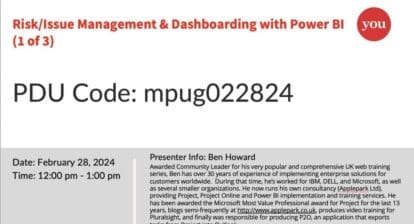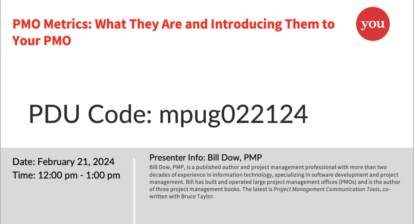
Several project management offices (PMOs) have asked for our help when they needed to manage resources effectively on both the project level and the portfolio level. To better manage resources, organizations need to look at their resource requirements in a defined order: 1) strategically, 2) tactically and 3) operationally. By homing in on these elements, you can get your PMO on the path to better resource management.
While there are a multitude of obstacles standing in the way of successful project completion — such as clarity of goals, scope creep, project leadership (or lack thereof), communication gaffes and risk planning — poor resource management is, arguably, the main reason projects fail. Project leaders start projects without properly understanding who is available and for how long — and whether that resource will be available consistently for the duration of the project. Asking the right resource questions upfront, prior to initiating the project, is key to managing the project through its entire lifecycle.
Strategically Planning across the Portfolio
There is power in being able to assess your resource requirements strategically across the portfolio. However, when the portfolio is being planned (often at the management level), little thought is given to potential resource challenges that can impact the project. Budget considerations and high-level project prioritization often take precedence over proper resource allocation. Resource planning is usually not considered until execution time, which leads to commitments that are great in theory but can’t be delivered. By understanding how resources should be allocated and what constraints and challenges should be expected in every role, strategic resource planning can set the table for successful portfolio execution.
Two things can make this happen:
Understanding your true capacity. True capacity is the consideration of project time, non-project time and non-working time for your resources. Project time is the planned, forecasted and actual task time required to achieve project tasks. Non-project time can be thought of as time spent on administrative and other non-specific activities on the project. Non-working time includes vacations, holidays and sick days.
- Use historical data that specifies actual work breakouts in the past to standardize planning-level metrics by role — across each group or the entire enterprise.
- Align resources to resource types instead of actual people. There’s a tendency to assign named people on projects; however, this makes capacity and resource planning difficult.
Sequence resource demand. This is critical to understanding the needed time on the project for each resource on a weekly or monthly basis. Is there seasonality to your resource workloads? By knowing trends in demand based upon actual history, you will be able to make better decisions across the portfolio.
It’s also important to engage mid-level management when discussing resource allocations. Since they’ll be entrenched in the projects and the team members work for them, they have a vested interest in ensuring that the planning is logical and that people don’t get burned out too quickly.
Tactically Maneuvering Resource Types
Once projects are underway, you’ll want a solid process for aligning project starts and work with resource availability. Although your organization may want to look at actual people at this point, you must resist the urge and continue to assign resource types that are necessary to keep the project progressing.
To implement resources tactically, you need to:
- Determine which resource types are needed across projects. This requires collaboration with a functional or resource manager.
- Utilize accurate metrics to figure out how many resource types are needed per project. With that data, you can map the actual resource availability for a given type or role. This forecasting capability will ensure that the portfolio is managed and staffed properly well in advance of work being performed.
- Understand non-project and non-working items, and track them at a sufficient level of detail to maintain accurate forecast capacity and availability.
- Put the project manager in charge of work forecasting — or calling out which resource types are needed and when — on each project.
- Make two-way communication the norm between the resource manager and team members.
By bringing the strategic “what” to the tactical “how,” project and resource managers can ensure that there are no resource shortages or disputes.
When this stage of planning is handled well:
- The lines of business that own budgets (and want results) will have more confidence that projects will be completed successfully;
- Resources are more likely to be assigned appropriately to meet the needs of the organization overall; and
- It will be more apparent what each resource requires to complete the project on time, within budget, and while meeting or exceeding customer expectations.
Resource managers should be held accountable for their management decisions. One way to ensure accountability is to hold review meetings to look at upcoming resource demand for the portfolio. These should be attended by resource managers, project managers, project stakeholders and any other interested parties. Decisions in these meetings should be made based on access to data (i.e., planned, actual and historical), and “memorialized” to keep a running history for future reference.
Resource managers must be particularly attuned to resource time-commitment issues at this stage that may affect the team’s ability to meet project objectives. They should constantly analyze the state of the resources needed on projects and what their available capacity is between project and non-project work to make sure the right resources are committed to the right work.
Operational Details Matter — But Only If You Get the Others Right
We see too many organizations go straight to the operational issues of resource management without thinking strategically or tactically first. That’s why resources are often allocated incorrectly.
If you take the strategic and tactical steps mentioned above first, the operational pieces will flow more naturally. The main operational resource-planning element is for resource managers to assign people to actual tasks, which require the resource manager to meet with the project manager to ensure that there are enough resources to meet project milestones.
As things change, stakeholders and managers can take a fully informed look at the portfolio of resources to figure out how to deliver a successful project. If resource planning across project and non-project work isn’t done well, it will become increasingly apparent. By taking the time to think strategically, tactically and then operationally, you can significantly increase your chances of project success.
Is this a no-brainer for you? Share your own resource management secrets with the MPUG community in the comments below.
A version of this article originally appeared on the Projility blog.






